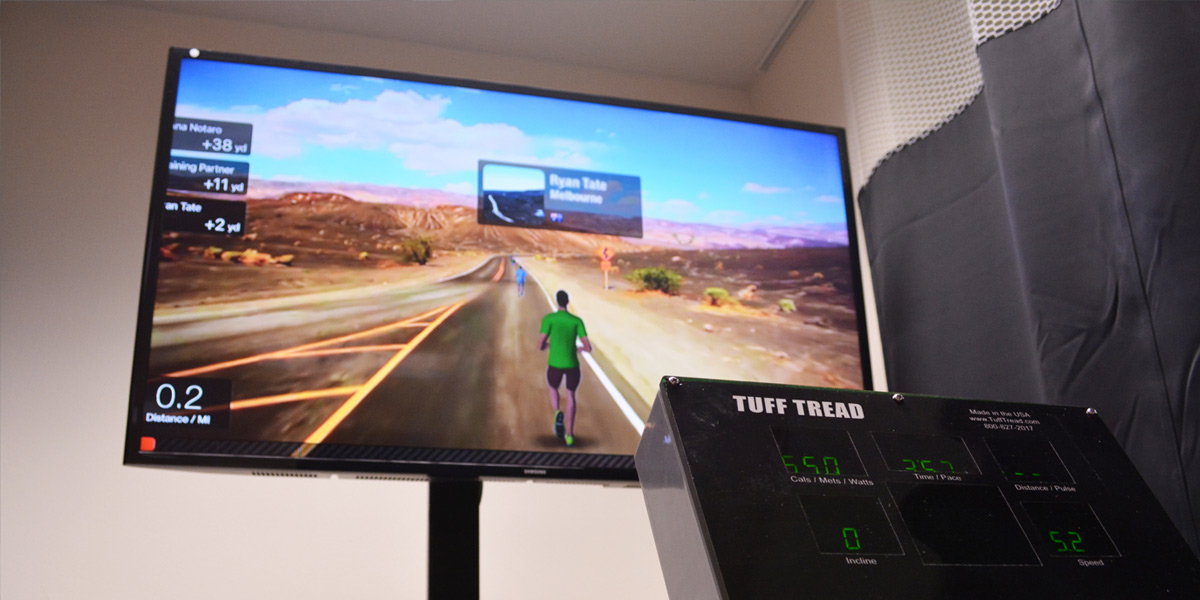- Future Students
- How to Apply
- Visit UHCL
- Admitted Students
- Tuition, Costs and Aid
- Degrees and Programs
- Contact Admissions
- Current Students
- Class Schedule
- Academic Calendar
- Advising
- Events
- Library
- Academic Resources and Support
- Student Services and Resources
- Alumni
- Lifetime Membership
- Alumni Events
- Update Your information
- Awards and Recognitions
- Give to UHCL
UHCL prof, students work with NASA to enhance exercise for astronauts
January 4, 2017 | George Mattingly II

For orbiting astronauts, the typical training environment includes daily exercise
in a tight space. With little more than a blank wall to stare at and perhaps music
and videos to view during a workout, staying motivated to exercise every day is a
concern for NASA.
A University Houston-Clear Lake professor is collaborating with a team at NASA’s Johnson Space Center to change that environment and improve astronauts’ health with the help of a $400,000 grant from the National Space Biomedical Research Institute (NSBRI).
NASA’s Principle Investigator (PI) and software developer Jeevan Perera along with Andrea Hanson, manager of Exercise, Physiology, and Countermeasures Laboratory, assembled the team. It includes NASA-JSC researchers, behavioral scientists, software developers, exercise scientists and William Amonette, assistant professor of Exercise and Health Sciences at UHCL, who serves as the team’s Science PI.
Together, they are focusing on improving exercise countermeasure software systems to allow for easy integration of virtual training tools on long-duration space flights.
The exercise components of the research grant focuses on two add-on features to the NextGen software being developed by Perera. The first incorporates an environmental and socialization exercise tool adapted from the mobile app, RunSocial. The app allows exercisers to train in a pre-recorded virtual environment and to engage with a virtual running partner while exercising on a treadmill. It also allows users from around the world to log on and run simultaneously, creating a unique opportunity to interact through exercise with people from different locations and countries.
“With this technology, an astronaut could theoretically log on to the app from space and run in a virtual environment of their choosing, such as a mountainous trail in the Swiss Alps, a beach in Australia, a snowy, tree-lined road in the mountains of Canada or eventually a city street in Houston. They could go for a run with a family member or friend back on Earth who is logged on at the same time,” Amonette said. He noted that this kind of motivation during exercise is key in improving enjoyment and adherence to regular regimen.
Secondly, the team is studying a newly developed virtual coaching tool for resistance exercise. Currently the coaching procedure for an astronaut in space is to video record the exercise session to be downloaded to Earth and evaluated by Astronaut, Strength, Conditioning and Rehabilitation Specialists (ASCRs). Feedback is then provided sometime later. The new coaching tool will provide astronauts with real-time feedback and instructional assistance.
The instructional training tool uses Microsoft Kinect cameras to display 3D skeletal structures of humans in movement. With input data from live sessions, the tool utilizes a machine-learning algorithm to identify common exercise errors and provide real-time solutions.
“This technology will allow the astronaut to see a skeletal display of their actual movement in real time simultaneously with a model of correct movement during the exercise set. It will provide coaching cues to correct mechanical errors in real time, which could help optimize performance and prevent injuries on long-duration space missions,” said Amonette. “It’s like observing your movement in a gym mirror, but the mirror is talking and providing feedback.”
Both components of this research are critical to astronaut health during long-duration missions and could have implications for human exercise on Earth.
“When in space for an extended period of time, there is muscle and bone loss due to the absence of mechanical loading in a zero-gravity environment,” said Perera. “Because of that, we have to counteract these loses with strength and aerobic conditioning. Having a healthy crew is a very valuable asset, so anytime we can work to streamline that process there will be lots of benefits especially as we extend space travel father away from earth and potentially for the health benefits for people at home or in the gym.”
Amonette’s role involves implementation of exercise experiments and testing the two add-on exercise components to the software in UHCL’s Human Performance Lab with the help of student research assistants from the Exercise and Health Sciences and Fitness and Human Performance program.
Together, they will conduct experiments to compare the effectiveness of each tool between designated groups using the enhanced software and those who do not. For UHCL students assisting on the project, Amonette said opportunity to contribute to ongoing field research is invaluable.
“This project could be part of more extensive research to continue refining a tool that might be used on future missions to the Moon or Mars,” he said. “The project could motivate students to pursue a career in science, or at the least be good consumers of science – they’ll learn to use sophisticated exercise tools, the logistics of research, how to read and interpret material and connect with working scientists at NASA.”
Amonette and the research team are beginning the testing phase of the project while some software is still being developed, with plans to complete the study in June. The team is currently looking for recreationally active volunteers between the ages of 25 and 50 from UHCL faculty, staff, students, or the surrounding community to participate in the project. For more information, contact Amonette at amonette@uhcl.edu.
UHCL’s graduate program in Exercise and Health Sciences program offers two concentrations, forging a path for students to careers in sport and exercise science, strength and conditioning, or public health and epidemiology. For more information, visit the College of Human Science and Humanities website at www.uhcl.edu/hsh.






